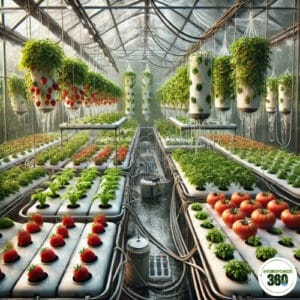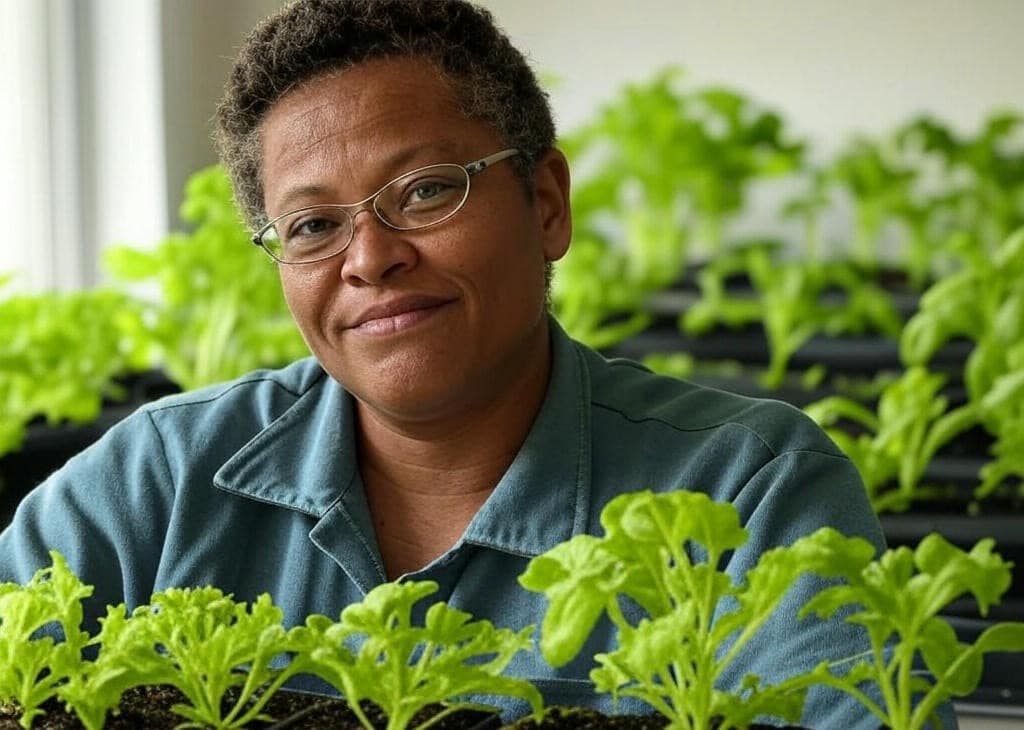The Rise of Hydroponic Fruit: Clean Farming
Table Of Content
Imagine biting into a perfectly ripe strawberry — grown without soil, pesticides, or unpredictable weather. Welcome to the world of hydroponic fruit, where innovation meets agriculture, and the future of farming is thriving indoors.
Whether you’re a curious gardener, a health-conscious eater, or a tech-savvy grower, hydroponic fruit cultivation offers a smarter, cleaner, and more sustainable way to enjoy nature’s sweetest bounty.

What Is Hydroponic Fruit?
Hydroponic fruit is grown using water-based systems instead of soil, allowing the plant roots to absorb nutrients directly from a mineral-rich solution. This method reduces dependency on farmland, eliminates soil-borne diseases, and promotes efficient use of water and space.
In hydroponics, conditions like light, temperature, humidity, and nutrient concentration are tightly controlled, allowing for more consistent and often faster growth compared to traditional agriculture.
Popular Fruits Grown Hydroponically
Not every fruit adapts well to a soil-less system, but many do — with impressive results. Here are some of the best candidates for hydroponic growing:
1. Strawberries
Strawberries are perhaps the most popular hydroponic fruit. They grow quickly, don’t require deep root zones, and produce delicious fruit with a relatively short harvest cycle. Hydroponically grown strawberries are often sweeter and juicier because the nutrient levels can be fine-tuned for flavor.
2. Tomatoes (Yes, they’re fruits!)
Tomatoes are technically fruits and one of the highest-yielding hydroponic crops. They require more space and pruning but reward growers with continuous harvests. By adjusting lighting and CO₂ levels, you can significantly improve both the size and taste of your tomatoes.
3. Blueberries
While blueberries are trickier due to their specific pH needs (4.5–5.5), they’re a great option for experienced growers. They require more patience but offer great long-term returns, especially for those interested in high-value niche markets.
4. Melons (Cantaloupe, Watermelon)
Melons are heavy feeders and require sturdy support, but they adapt surprisingly well to hydroponics. They thrive in systems like deep water culture or raft setups, where their roots have consistent access to oxygenated nutrient solutions.
5. Pineapples
This exotic fruit may take up to 18 months to mature, but the reward is worth it. Pineapples grow well in drip systems with coco coir and can be an exciting project for hobbyists or boutique growers seeking to offer rare hydroponic produce.
Why Choose Hydroponic Fruit Farming?
Hydroponic fruit farming is more than a trend — it’s a shift toward resilient, sustainable agriculture.
Cleaner, Safer Produce: With no soil involved, your fruits are less exposed to pathogens, pests, and chemical contaminants. The result is cleaner, healthier produce that often requires little to no washing.
Year-Round Production: Forget about seasons. With hydroponics, you can grow fresh fruit 365 days a year, no matter the climate outside. This is especially beneficial for cold or urban environments where outdoor farming isn’t feasible.
Water Efficiency: Hydroponic systems recycle water, using up to 90% less water than soil-based agriculture. This makes it ideal for regions facing drought or limited water supply.
Higher Yields in Less Space: Vertical stacking, rack systems, and tiered trays make it easy to grow more fruit in a compact area, making hydroponics a top choice for indoor or urban farming.
Customization & Control: From root zone temperature to nutrient dosing, every part of the growing process can be custom-tailored to the plant’s needs, resulting in better flavor, size, and texture.
Nutritional Comparison: Hydroponic vs. Soil-Grown Fruits
One of the most frequently asked questions about hydroponically grown produce is, “Is it as nutritious as soil-grown fruit?” The short answer? Yes — and sometimes even more so.
Hydroponic systems allow for precise control over nutrient delivery, ensuring that plants get exactly what they need, when they need it. This often results in fruit that is:
- Richer in certain vitamins like C and A
- More consistent in flavor and size
- Less contaminated with heavy metals or pesticide residues
What the Research Says
Several studies have shown that hydroponically grown fruits like tomatoes and strawberries contain comparable or higher antioxidant levels, depending on the nutrients provided. For example, hydroponic strawberries often show increased flavonoid and anthocyanin content — both powerful antioxidants.
That said, the nutritional value of any fruit is influenced by multiple factors, including:
- Harvest timing
- Light exposure
- Nutrient formulation
- Genetics of the cultivar
With optimal system management, hydroponic fruit can match or exceed the nutrient density of traditional crops — all without soil-related risks.
Getting Started with Hydroponic Fruit
Hydroponic fruit farming may sound intimidating, but it’s more accessible than ever thanks to beginner-friendly kits and modular systems.
Start small — perhaps with a Kraky bucket for tomatoes or a vertical NFT tower for strawberries. Learn how your plants respond, then scale up once you’re confident with pH balancing, light scheduling, and nutrient management.
Pro tip: invest in a reliable pH meter and grow light. These are critical to ensuring your fruits flower and ripen correctly.
Common Mistakes to Avoid
Hydroponic fruit growing comes with a learning curve. Here are pitfalls to dodge:
- Neglecting root support: Heavier fruits need trellising or netting to prevent snapping stems.
- Wrong nutrient ratios: Fruit-bearing plants have different nutritional needs during flowering. Don’t stick to one formula.
- Skipping pollination: Indoor fruiting crops like tomatoes and melons often need manual pollination.
- Poor ventilation: Lack of airflow can lead to mold, mildew, or overheating in enclosed setups.
Avoiding these mistakes will help you achieve consistent, healthy harvests from your hydroponic system.
Market Trends and Commercial Demand
The global demand for hydroponically grown fruit is steadily rising, fueled by a combination of consumer health awareness, food safety concerns, and technological innovation in agriculture.
Key Growth Drivers:
- Urbanization & Space Efficiency: As cities grow, there’s less arable land available. Hydroponics allows for high-density, vertical farming in urban centers.
- Clean Label Movement: Consumers increasingly seek produce that is pesticide-free, GMO-free, and locally grown — all benefits of hydroponic fruit farming.
- Supply Chain Security: Hydroponic systems enable local year-round production, reducing dependence on global shipping and reducing spoilage.
Stats to Watch:
- The global hydroponic produce market is expected to surpass $20 billion by 2028, with fruit crops like strawberries and tomatoes leading the charge.
- Retailers and restaurants embrace “farm-to-table hydroponic sourcing”, especially in premium, organic, and zero-waste establishments.
- Startups are emerging that specialize in hydroponic berries, herbs, and even fruit kits for consumers — a fast-growing niche within the gardening industry.
Commercial Opportunity:
Hydroponic fruit farming is particularly lucrative in:
- Climate-restricted regions (e.g., deserts, cold climates)
- High-end retail and hospitality markets
- Subscription-based models (e.g., CSA boxes with specialty fruits)
In short, hydroponic fruit is no longer just a hobbyist trend — it’s a viable business model and a key player in the future of food.
The Future of Fruit is Hydroponic
As the world’s population grows and arable land becomes scarce, hydroponic fruit farming offers a scalable and eco-conscious solution. From rooftop gardens in New York to desert farms in Dubai, growers are proving that soil isn’t a necessity for producing delicious fruit.
Hydroponics enables communities to grow locally, reduce transportation emissions, and maintain food security — all while delivering nutrient-dense produce to tables worldwide.
FAQs
Can hydroponic fruits be certified organic?
Not everywhere. In the U.S., hydroponics can be USDA certified organic, but in some countries, like those in the EU, soil is required for organic labeling. However, hydroponic fruits are often marketed as “pesticide-free” or “clean-grown.”
How do I prevent pests in hydroponic fruit systems?
Even without soil, pests like aphids, whiteflies, or spider mites can still infiltrate indoor systems. The best defense is integrated pest management (IPM): use insect netting, natural predators (like ladybugs), neem oil, and clean air circulation systems.
Can I grow hydroponic fruit in an apartment?
Yes! Compact systems like vertical towers or balcony drip setups make it possible to grow strawberries, dwarf tomatoes, or even citrus in apartments — especially with LED grow lights and odor control.
How do flavor and shelf life compare with store-bought fruit?
Hydroponically grown fruit, harvested at peak ripeness, is often more flavorful and aromatic than store-bought produce, which is picked early for transport. Shelf life may vary, but fresher harvests often mean less spoilage at home.
Do hydroponic fruits contain synthetic chemicals?
Not inherently. The nutrient solution uses minerals in ionic form, the same way plants absorb them from soil. There are organic-compatible hydroponic nutrients available if you want to keep your system all-natural.
Is it cost-effective to grow fruit hydroponically at home?
In the long run, yes — especially if you consume a lot of fruit. After the initial setup, you can reduce grocery bills, minimize waste, and enjoy better quality control. For high-cost fruits (like berries), it can be a smart investment.
What fruits shouldn’t be grown hydroponically?
Large trees like mango, avocado, or jackfruit are difficult to manage due to size and root structure. These typically require soil for anchorage and long-term nutrient access. Focus on compact, bushy, or vine-based fruits instead.
Table Of Content
